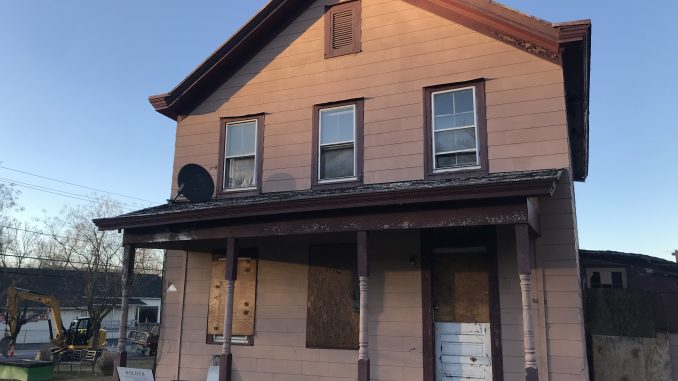
The New Paltz Village Board of Trustees honored Stewart’s Shops 2022 Partners in Preservation award on Jan. 25 for their work in the Oliver House preservation effort.
Built in 1885, the Oliver House sits behind Stewart’s on 5 Broadhead Ave. It is one of the few remaining homes built by Jacob Wynkoop, one of the first Black Americans to buy property in the village. The House was named after its original owner Richard Oliver, who was born free in 1829. Both of his parents were formerly enslaved. He became a Civil War veteran and later died of malaria on his way home from battle. His wife Ann and their children lived in the house at the time of his death.
Few Black people were able to own land and homes at the time, illustrating how significant the Oliver House is as a home built by a Black landowner and owned by a Black family. It represents a timeless piece of Hudson Valley’s Black history.
“We generally try to do as much as we can with our municipal partners,” said Stewart’s real estate representative and project manager Chuck Marshall. Marshall accepted the award on behalf of the company at Jan. 25’s Village Board of Trustees meeting. The Design Review Board and Historical Preservation Committee presented the award.
Marshall was heavily involved in Stewart’s relocation process from the start. When the new location for the store was proposed, Stewart’s was unaware of the significance of the Oliver House. It was not listed in the state’s Historical and Cultural Resources database.
“When the Preservation Commission reached out, it was an easy gift for us,” said Marshall.
The Partners in Preservation award is given to individuals whose properties enrich and improve the community. Stewart’s is the first corporate recipient of the award. Commissioner Tom Olsen called the award the “most culturally significant Partners in Preservation award we’ve ever made.”
“It means an opportunity to show a public private partnership,” Marshall said of the award. “A company that’s from, for lack of better terms, ‘out of town’ can work with the people in town to meet desired outcomes for both parties. I think it’s an example of how things should be done.”
When Stewart’s originally purchased the property that the House was built on, it was slated for demolition. The store was set to relocate to the corner of N. Chestnut Street and Henry W. Dubois Drive. Early in the store’s relocation process, New Paltz Mayor Tim Rogers reached out to the company in hopes to acquire the House for the public trust. Although Rogers called the donation request a “long shot,” Stewart’s complied. The building was sold to the Village of New Paltz for $1.
Marshall also thanked the cooperation and eagerness of the Village Board of Trustees. He named Commissioner Olsen and the planning board chairperson of the project Eve Walter, commending them for their work.
“The step-by-step process that everyone went through to make this achievable was a big win for everybody. While Stewart’s was able to make that final donation for the house and trail, I think at the end of the day, Stewart’s is a component of a cog. They’re not the only cog in the wheel,” said Marshall.
Beyond the donation of the Oliver House, Marshall said that his team aimed to improve the town as much as possible in their relocation project. During the process, Stewart’s paid for a traffic light at the intersection of their new location to improve traffic circulation. The company also donated a multi-use path on the nearby Empire State Trail.
While Marshall did not name other specific preservation or town improvement efforts that Stewart’s is undertaking, he said philanthropic giving is a core component of Stewart’s as a company. Throughout the year, the convenience store company donates about $7 to $8 million to communities its stores are located in. Marshall specifically noted the Holiday Match program, which donates around $2.5 million each holiday season to children’s charities.
After the donation, the town investigated several proposed uses for the house. All proposals were considered, but Mayor Rogers prioritized plans that would commemorate the Oliver family, Wynkoop and New Paltz’s Black History.
The House is now becoming a Black cultural center in New Paltz. Attorney and Board trustee Esi Lewis first submitted the preservation plan and holds stewardship of the house and property. Lewis is the daughter of Dr. Margaret-Wade Lewis, a civil rights activist and one of the founders of SUNY New Paltz’s Black studies department.
“The donation of the historic Ann Oliver House by Stewart’s Shops is a true testament to their community spirit and dedication to preserving the past for future generations,” Lewis said.
The house, now dubbed the Dr. Margaret Wade-Lewis (MWL) Black History Cultural Center, is dedicated to the Black community of the Hudson Valley. It seeks to “house artifacts, books and research” about the community and host “cultural, educational, mental, physical and emotional wellness empowerment programming.”
Restoration efforts are currently underway and donations can be made at mwlcenter.org. Contact info@mwlcenter.org for more information on the center.
